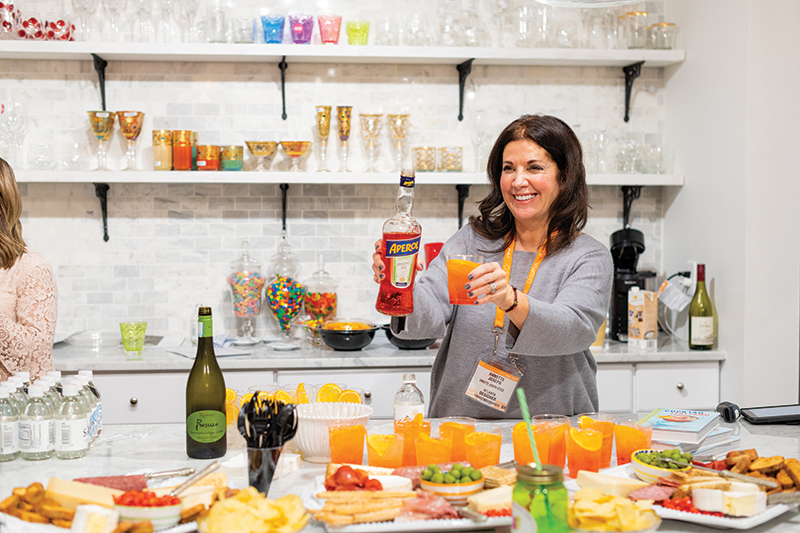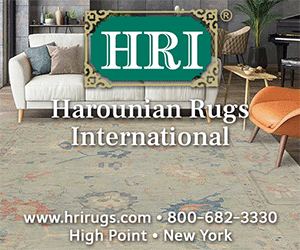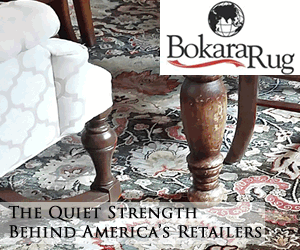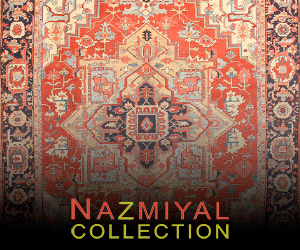InConversation with PAIGE ALBRIGHT: We asked proprietress Paige Albright of Paige Albright Orientals in Birmingham, Alabama her thoughts on the state of the “Atlanta” market: the Atlanta International Area Rug Market™ and the National Oriental Rug Show. She responded with thoughts on that market as well as on the relationship buyers have to markets globally. This is her perspective.
The AmericasMart building in Atlanta, Georgia has been hosting a variety of furnishings and gift shows since it first opened its doors in 1957, including of course the National Oriental Rug Show, NORS, produced in conjunction with the Oriental Rug Importers Association, ORIA. The Architect of the complex, John C. Portman, was a great supporter of the hand-knotted rug industry and it was under his tutelage that “Atlanta,” as the market is commonly known, first welcomed rug exhibitors onto its floors. Much has changed since those early years, however, and arguably even more has changed since the salad days of NORS in the late 1990’s through the mid-oughts of this century. While the rug industry sees “Atlanta” as a rug market, the facility itself was designed and built as permanent wholesale showroom space, and so it is today that AmericasMart continues to flourish even if the importance of handmade rugs and carpets in Atlanta has diminished.
“I started going to the Atlanta market in the late 1990’s,” begins Paige Albright. “All the important New York City vendors had showrooms and would bring a wide selection to this regional market. It was like having a slice of New York in Atlanta. You wouldn‘t dare miss an opportunity to see new inventory and see other rug retailers from around the country. It was a great learning experience with great camaraderie. I learned how to distinguish weave and pattern by flipping through stacks of rugs and being quizzed on provenance and age. It was awesome!” Contrast that glowing praise with her terse thoughts on the January 2019 market she attended. “Now, none—not one of those New York vendors comes to Atlanta. It is sad for me.” And so, the sense of decline long discussed privately finally comes into the public domain.
That is not to say AmericasMart or its other shows actually are in decline—they are not. It is rather to illustrate that the same forces that led to the decline in New York dealers’ attendance at Metro Market Week (see ‘The Rug Show’, this issue, pages 34-39), are also at play in Atlanta. Indeed they are at play globally, as hand-knotted and handmade give way to machine-made, hand-loomed, tufted, printed and whatever newer technology comes along. AmericasMart has simply adapted its business model to focus on segments of the giftware and home furnishings market that are performing well. Albright again, “Honestly there are now fewer [rug] vendors to choose from in Atlanta; more serious buyers attend ‘the New York show’.”

The Atlanta market has also become overrun with interior designers and gift shop buyers. Or buyers purchasing personal pieces rather than stocking a shop or showroom.” Albright’s observations are disheartening to those who remember those halcyon days of rug trading in Atlanta, yet “being overrun with customers” is a problem the hand-knotted rug and carpet industry only wishes it had; simultaneously it must sound positively upbeat to the show’s organizers.
“The rug market is shrinking. There are fewer wholesalers available to serious buyers. Wholesale rug vendors are now selling directly to the public, eliminating [or at least putting severe pressure upon] the rug retail market. There is a blurred line between wholesale, designer pricing, and retail,” according to Albright. This blurring trend however is not unique to Atlanta, and can be found across virtually all trade shows with varying degree of intermixing ranging from the liberal “everyone is welcome” shows to the more restrictive ones that allow a single “public day.” In sum, the flattening of supply chains that has been ‘disrupting’ other industries for years, seems finally to have arrived with full force in the rug industry.
“Wholesale vendors have gotten savvy, marketing via 1st Dibs and linking directly to their own websites,” says Albright of the market dynamic today, before adding, “Along with eBay, etsy, [and individual commerce websites] that offer online portals directly to the source, you can find anything through a google search.” While Albright is saddened to see the changes underway in the industry, she is practical in her approach, rolling with the tide if you will. “We also have to continue to evolve. For example, Tamarian has a great idea to share inventory among dealers. [See RUG INSIDER Winter 2019, “The Rug Club”, pages 42-45] It makes acquiring new fresher pieces less intimidating as it broadens the retail market for everyone.”
That statement may have been broader and more prescient than Albright initially intended. Replace “acquiring new fresher pieces” with “buying a rug,” remove “retail,” and you get ‘It makes buying a rug less intimidating as it broadens the market for everyone.’ In short, the proverbial cat is out of the bag and now we just have to figure out how to live with cats.
Albright points to exhibition costs as one reason for the decline in exhibitors in Atlanta. “Showroom rent, freight, time away from New York [or wherever the home office may now be], cost to travel and exhibit have become more than total market sales. The recession really hit the rug market hard in 2008. Antique rugs are a luxury. [Editors note: All rugs are a luxury, some more than others.] The industry pared down and with that regional markets [such as Atlanta] became less of a priority. It is easier to sell online or at the New York show or in New York showrooms. The buyer [purchasing for retail resale] has adjusted to this and no longer attends, or needs to attend, regional shows. As regional markets like Atlanta, Dallas, Las Vegas, and maybe even High Point cater to designers and home stores, there is less focus on handmade, hand-knotted, antique, and “authentic” rugs in those marketplaces.”

Instead larger rug companies who make rugs and carpets with styling, pricing, and quality more akin to fast fashion than heirloom now dominate the regional markets. In defense of such firms, anyone who has walked through a showroom (at any show) selling machine-made, tufted, and other highly accessible price-point rugs can plainly see where the real money in the rug industry now lies. See showrooms such as Oriental Weavers, Nourison, Surya, or Loloi. As such, the decline of old-school handmade exhibitors is as much symptom as it is illness. “It has become increasingly expensive for vendors to show in regional markets when there are fewer buyers and therefore fewer sales.” concludes Albright.
It’s not just the decline of handmade and hand-knotted prominence, some might say dominance, in the marketplace that concerns Albright, but also a move away from education, structured or otherwise. “At one time there were lectures on any number of topics. I vividly remember an Afghan exhibit as well as an Armenian rug exhibit. Both were amazing!” At the same time, Albright is eager to praise exhibitions and organizations that retain that element of knowledge the hand-knotted industry has long favored. “Whether it is IHIB—referring to the Istanbul Carpet Exporter’s Association by its Turkish acronym—or Domotex, both offer an unparalleled variety and an actual focus on handmade and hand-knotted [rugs]. It is also easier for international dealers/craftsmen/wholesalers to travel to a midpoint in Istanbul or Hannover. There are no embargo restrictions and there are far more buyers, giving these more global markets broad international appeal.”
Albright’s observations and laments are in no way an indictment of AmericasMart or NORS, but really a wistful reflection of drastically shifting consumer rug habits in North America. For those who, like Albright, trade in handmade and hand-knotted rugs and carpets via a specialty retail shop, it is challenging to adapt. “We need to talk to one another and share ideas. My market in Alabama is unique [as are others] but we all share common issues—retail woes, repair, business ideas. I love seeing my rug friends and talking with them about everything, be it life, rugs, the market, what have you. I try to bring a fresh perspective and inspire them as well. Handmade is important both historically and as a template for modern production. We all have to do our part for the industry to survive.”
When asked what she feels would benefit a show such as NORS or any show catering to hand-knotted, Albright readily responds, “There should be a handmade section or a handmade-specific show. I did not enjoy walking down quiet hallways with dark, closed showrooms in Atlanta. I wish they would consolidate everyone to two floors instead of several half empty ones. It's depressing. Maybe it’s a temporary section that really accentuates the market feel and not a forced showroom situation. Bring back a souk-like experience to project more soul to vendors and buyers alike.”
www.americasmart.com
www.oria.org
www.paigealbrightorientals.com
IMAGES COURTESY OF AMERICASMART ATLANTA.





